RAMP
RADARSAT-1 Antarctic Mapping Project
Carried aloft by a NASA rocket launched from Vandenburg Air Force Base on November 4, 1995, the Canadian Radarsat-1 is equipped with a C-band Synthetic Aperture Radar (SAR) capable of acquiring high resolution (25 m) images of Earth's surface day or night and under all weather conditions. Along with the attributes familiar to researchers working with SAR data from the European Space Agency's Earth Remote Sensing Satellite and the Japanese Earth Resources Satellite, RADARSAT-1 has enhanced flexibility to collect data using a variety of swath widths, incidence angles and resolutions. Most importantly, for scientists interested in Antarctica, RADARSAT-1 can be maneuvered in orbit to rotate the normally right-looking SAR to a left-looking mode. This 'Antarctic Mode' provides capability for the first time of nearly instantaneous, high-resolution views of the entirety of Antarctica. The first Antarctic Mapping Mission (AMM-1) began on September 9, 1997 and was successfully concluded on October 20, 1997. The second, AMM-2 began on September 3, 2000, and was successfully concluded on November 17, 2000. For both projects, The Ohio State University provides overall project and scientific direction as well as producing final products. The Alaska SAR Facility is responsible for data acquisition and processing signal data to images. The Jet Propulsion Laboratory is responsible for developing acquisition strategies and for data processing system development. Vexcel Corporation is responsible for developing the RADARSAT Antarctic Mapping System used by Ohio State to create final products. The project is advised by a science team composed of researchers from around the world.
Antarctic Mapping Mission -1
The Goal:
Antarctica is the coldest, windiest and, on average, highest continent on Earth. Shrouded in darkness during the austral winter and often obscured from view by persistent cloud cover, Antarctica has remained one of the most poorly mapped parts of our planet. That situation changed in 1997 when RADARSAT-1 began to scan Antarctica from space. The goal of the project was to create the first, high resolution, radar image of the continent. The resulting map was intended to serve as a benchmark for gauging future changes in the polar ice sheet, to understand more about the behavior of the glacier and its interaction with the polar atmosphere and coastal ocean, and to simply expand our ability to explore the vast, remote and often beautiful, southernmost continent.
The Approach:
The first Antarctic Imaging Campaign (AIC-1) was made possible by the unique capabilities of RADARSAT-1 including an electronically steerable antenna array that provided a range of selectable beam pointing angles. This capability was essential for maximizing the range of the acquisition swaths away from the satellite nadir track. The satellite also can maneuver in orbit enabling it to change the look direction of the SAR. These two capabilities permitted acquisitions to the Earth's South Pole and represent technical abilities afforded by no other civilian spaceborne radar.
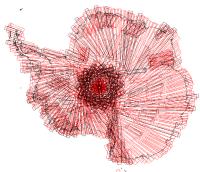
AIC-1 acquisitions began seven days earlier than the anticipated start of the nominal acquisition plan. The early data constituted an important contingency against anomalies encountered later in the mission. Nominal acquisitions started on schedule shortly after noon Eastern Standard Time on September 26. The nominal plan was designed to obtain complete mapping coverage within 18 days. The nominal plan proceeded nearly flawlessly through completion on October 14. It was executed in parallel with acquisition plans for other RADARSAT-1 users and with CSA's Background Mission. An additional opportunity was realized because of the early start on September 19. Radar data collected after the conclusion of the nominal mission were acquired exactly 24 days after the beginning of the early start data. This schedule repositioned the spacecraft to within a few hundred meters of its position 24 days earlier. Consequently the data are suitable for interferometric analysis - a demonstrated technique for estimating ice sheet surface displacement. Exact repeat data collections started on October 14 and continued through October 20.
Preparations to return the satellite to normal operations began on October 20. Arctic mode operations resumed on October 23. Acquisitions for customers resumed on October 26. This occurred 9 days ahead of the planned schedule.
The Mosaic:

The RAMP mosaic, shown here at reduced ( click here for a five kilometer version ) resolution is truly a new view of Antarctica. We observe several new and exciting features about Antarctica from the mosaic. First, there are large-scale spatial variations in radar brightness. The bright portion of Marie Byrd Land and the eastern sector of the Ross Ice Shelf probably represent the region where significant melting and refreezing occurred during an early 1990's melt event. Most of the coastal areas and much of the Antarctic Peninsula appear bright also because of summer melt. But unlike Greenland, where most of the large-scale brightness patterns are associated with firn melt facies, the remaining, strong variations in radar brightness are poorly understood. Many of the thousands of kilometer long curvilinear features across East Antarctica appear to follow ice divides separating the large catchment areas. Ice divides derived from topographic information and overlaid onto the mosaic demonstrate the good but difficult to explain correlation between ice divides and radar brightness patterns. On an intermediate scale, the East Antarctic Ice Sheet appears to be very 'rough'. The texturing is probably due to the flow of the ice sheet over a rough glacier bed. Textures are particularly strong paralleling the flanks of the Transantarctic, Pensacola and Shackelton Mountains and extending deep into adjacent portions of the East Antarctic Plateau. Long linear patterns are strongly suggestive of subglacial geology and may indicate that the ice sheet in this area is resting on relatively resistant basement rocks. The texture changes abruptly across the northernmost section of the Wilkes Subglacial Basin located in George V Land. There the imagery shows remarkable, subtle rounded shapes similar in appearance to the signature of subglacial lakes such as Lake Vostok.

Most intriguing are ice stream and ice stream-like features of the East Antarctic Ice Streams in Queen Maud Land partly described in previous research using optical imagery. Ice streams are made visible by the intense crevassing along the shear margins where chaotic surface roughness results in a strong radar echo. Complexities within the interior of the ice streams are revealed by radar flow stripes that probably originate from subtle variations in topography. Slessor Glacier is located on the northeastern margin of the Filchner Ice Shelf. The upper reaches of the glacier are funnel-shaped with the interior of the funnel punctuated by patches of crevasses. The ice stream is about 450 kilometers long from the grounding line to the upstream area that seems to be characterized by several long scars. The scars are probably shear margins but it is not possible to deduce whether they are recently initiated or relict ice stream flow. An enormous ice stream, reaching at least 800 kilometers into East Antarctica, feeds Recovery Glacier. It too is fed by a funnel-shaped catchment. Down-glacier, crevasses cascade across the ice stream at several locations suggesting strong variations in basal topography modulates the flow. The confluence of a thin, elongated, 280 kilometer-long tributary ice stream with Recovery Glacier is located approximately 250 kilometers from the constriction where Recovery Glacier enters the Filchner Ice Shelf. The central body of the pipe-like tributary is crevasse free indicating that shear stresses are concentrated only at the margins. The tributary is an enigma in that there is little evidence for ice flow into the tributary from the adjacent ice sheet and there is little if any indication as to the source of ice from the up-glacier catchment region. A less active pipe-like tributary merges with Recovery Glacier just upstream of the grounding line. The uppermost portion of that 300 kilometers long tributary is dark and featureless, similar to the eastern companion. Down-glacier, the tributary surface is similarly mottled to the adjacent ice sheet. Using RADARSAT SAR imagery obtained during the 1997 Antarctic Mapping Mission, ice velocity vectors were obtained over the East Antarctic Ice Streams (see figure above). The upstream velocity of the Recovery Glacier is about 100 meters/year (light blue areas). Near the grounding line there is a local peak velocity of about 900 meters per year (yellow and red areas).
Antarctic Mapping Mission - 2
Why AMM-2?
Glaciers and ice sheets move under the load of their own weight. They spread and thin in a fashion dictated by their thickness, the material properties of ice, and the environmental conditions on the glacier surface, sides and bottom. Measurements of Antarctic Ice Sheet surface motion are of keen interest to geoscientists. The rate and direction of motion reveals important information about the forces acting on the glacier, provides knowledge about the rate at which ice is pouring into the coastal seas, and enables scientists to predict how the ice sheet might respond to changing global climate.
Glacier motion has intrigued scientists and lay people for over a century. In 1880, the American author Mark Twain wrote of his experiences with Alpine glacier motion in his book, A Tramp Abroad, "I was aware that the movement of glaciers is an established fact; so I resolved to take passage for Zermatt on the great Gorner Glacier. The next thing was how to get down the glacier comfortably. I marched the Expedition down the steep and tedious mule-path and took up as good a position as I could upon the middle of the glacier--because Baedeker said the middle part travels the fastest. I waited and waited, but the glacier did not move. Night was coming on, the darkness began to gather--still we did not budge." While Twain was disappointed in the outcome of his idea, his approach was essentially correct. Since the International Geophysical Year of 1957-58 and before, scientists have placed markers on the ice sheet and then, using a variety of navigation techniques from sun shots to GPS, have measured and re-measured their positions to calculate motion. More recently, scientists have used high-resolution satellite images to track the position of crevasses carried along with the glacier to compute surface motion. But all of these approaches are time consuming and result in patchy estimates of the surface velocity field.
During the early 1990's, researchers at the Jet Propulsion Laboratory showed that synthetic aperture radar (SAR) offered a revolutionary new technique for estimating the surface motion of glaciers. Here, the SAR is operated as an interferometer. That is, the distance from the SAR to a point on the surface is computed by measuring the relative number of radar-wave cycles needed to span the distance between the radar and the surface. Later, another measurement is made from a slightly different position and the numbers of cycles is computed again. The difference in the number of cycles is used to estimate displacement to about one quarter of a radar-wave cycle (just a few centimeters for RADARSAT-1!). The demonstration of this technique for SARs in general and the demonstration during AMM-1 that the technique worked for RADARSAT-1 in particular were the impetus for the Antarctic Mapping Mission -2 (AMM-2) which occurred during the fall of 2000 as part of a joint Canadian Space Agency and U.S. National Aeronautics and Space Agency project to map the Southern Continent.
AMM-2 had two primary science objectives. The first was to re-map the perimeter of the continent and the majority of Antarctica's fast moving glaciers. Intuitively, these are the areas that are most likely to have experienced change over the three years that followed after the first mission, and as discussed below, we have results demonstrating that this objective is a success. The second MAMM objective was more ambitious, that being to obtain as much surface velocity data on the ice sheet as possible.
The New Approach:
Acquisitions were planned in two ways to reach this goal. First, data were acquired so that, where possible, the position of structures on the glacier could be compared between the 1997 and 2000 data sets so as to measure point velocities. Second, and the real challenge of MAMM, was to acquire interferometric data so as to estimate velocity fields. The second approach required the use of RADARSAT-1 fine and standard beams, and the unprecedented control of the spacecraft orbit and attitude. As the mission unfolded, CSA spacecraft engineers demonstrated a remarkable ability to navigate the satellite in the manner dictated by the science requirements. The outcome of this combined effort are extraordinary observations of glacier motion captured over three 24-day RADARSAT cycles.

MAMM acquired data from about 80 degrees South Latitude to the Antarctic Coast. Interferometric SAR calculations required that this area be imaged six times during the mission (three times in descending orbit mode and three times in ascending orbit modes). The number and orientation of acquisitions then enable scientists to measure two components of the surface velocity vector and to remove the effects of surface topography. The MAMM data are being processed into images by the Alaska SAR Facility. The Ohio State University will convert the images into maps and velocity fields using a system being developed by Vexcel Corporation. Once complete (about one year for the first mosaic and about three years for the velocity field maps) the products will be made available to the international science community.
Some Early, AMM-2 Results
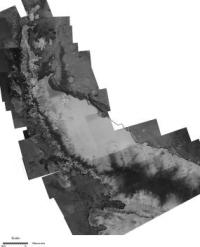
Even over just a three year period, the Antarctic Ice Sheet can change appreciably. Some of the most dramatic changes on the continent are occurring along the Antarctic Peninsula imaged in 2000 by RADARSAT-1. The black line on the image to the left is the coastline measured using RADARSAT-1 data acquired in 1997. The results document the continued retreat of the northern Larsen Ice Shelf - over 30 kilometers (18.6 miles) in just three years. The astonishing retreat of the Larsen Ice Shelf is dramatically captured in this image and seems to add credence to a 1978 prediction that collapse of the Antarctic Peninsula Ice Shelves would a precursor signal to more global scale consequences of greenhouse gas warming. But this is not the whole story. We also observe places where the ice sheet is advancing, such as the Amery Ice Shelf. The Antarctic Ice Sheet is huge, and this is the first time we have the data to study and compare ice sheet behavior around the entire continent. These data will help us determine whether the local changes we see represent expected episodic behavior or whether they represent regional trends driven by changing climate.
Lambert Glacier and Amery Ice Shelf (1997-lambert)
This mosaic of RADARSAT SAR images is centered on the Lambert Glacier, one of the largest and longest of Antarctica's glaciers, draining about 900,000 kilometers2 of East Antarctica. Several smaller ice streams on the eastern half of the image, channeled by numerous exposed mountains including the Mawson Escarpment to the south, merge into the Lambert which broadens as it eventually flows into the ocean forming the Amery Ice Shelf. The Lambert has clearly visible surface flowlines that extend hundreds of kilometers into the interior. In the center section, isolated features on the ice shelf that appear bright in the radar image are likely due to past occurrences of surface meltwater which accumulated into small lakes and troughs. This mosaic was derived from RADARSAT imagery obtained during the 1997 Antarctic Mapping Mission and shows an area approximately 900 kilometers by 675 kilometers (560 by 415 miles). The Lambert Glacier is centered at approximately 72 degrees south and 67.5 degrees east.
Lambert Glacier Velocity Map (velocity-lambert image, Movies/ant-flyover-animation)
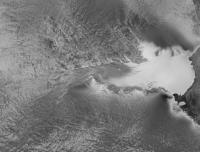
This mosaic of RADARSAT SAR images is centered on the Lambert Glacier, one of the largest and longest of Antarctica's glaciers, draining about 900,000 kilometers2 of East Antarctica. Several smaller ice streams on the eastern half of the image, channeled by numerous exposed mountains including the Mawson Escarpment to the south, merge into the Lambert which broadens as it eventually flows into the ocean forming the Amery Ice Shelf. The Lambert has clearly visible surface flowlines that extend hundreds of kilometers into the interior. In the center section, isolated features on the ice shelf that appear bright in the radar image are likely due to past occurrences of surface meltwater which accumulated into small lakes and troughs. This mosaic was derived from RADARSAT imagery obtained during the 1997 Antarctic Mapping Mission and shows an area approximately 900 kilometers by 675 kilometers (560 by 415 miles). The Lambert Glacier is centered at approximately 72 degrees south and 67.5 degrees east.
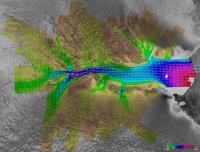
Using RADARSAT SAR imagery obtained during the 2000 Antarctic Mapping Mission, ice velocity vectors were obtained over the Lambert Glacier. The areas of no motion (yellow) are either exposed land or stationary ice. The smaller confluent glaciers have generally low velocities (green, 100-300 meters per year) which gradually increase as they flow down the rapidly changing continental slope into the upper reaches of the faster flowing Lambert Glacier (click on ant-flyover-animation). Most of the Lambert itself has velocities between 400-800 meters per year, with a slight slowing in the middle section. As the glacier extends across the Amery Ice Shelf, velocities increase up to 1000-1200 meters per year as the ice sheet spreads out and thins. Only a handful of in situ velocity measurements have been previously reported of this huge glacier system. While the in situ and radar-derived measurements appear to be qualitatively similar, the extent and accuracy of the new measurements are unprecedented and provide quantitative baselines for future comparisons. The ice velocities are obtained from pairs of images obtained 24 days apart, using a technique called radar interferometry. This technique enables a highly precise alignment of image pairs that provides accurate measurements of topography as well as surfaces that have changed or moved over the short time interval, including glaciers.
Amery Ice Shelf (amery-blue, amery-temporal)
This RADARSAT SAR image mosaic of the Amery Ice Shelf is obtained from the 2000 Antarctic Mapping Mission. In general, the shelf is overall brighter than the Lambert Glacier due to previous occurrences of surface melt, which alters the ice crystals sufficiently to produce higher radar returns. The blue coastline is derived from the 1997 Antarctic RADARSAT mosaic, indicating that the ice shelf edge has extended seaward about five kilometers (three miles) over the three year interval. The yellow coastline dates from the mid-1970's, indicating that the Amery has been in a period of general advancement, having moved about 25 kilometers (15.5 miles) over approximately a 25 year period. Note that the coastal areas adjacent to the Amery Ice Shelf on both sides show little change in extent. The two Antarctic mosaics provide highly accurate baselines needed for future comparisons. This image is centered at approximately 69 degrees south and 72.5 degrees east, covering an area about 115 by 165 kilometers (70 by 100 miles).
Shirase Glacier (shirase-blue, shirase-glacier, Movies/shirase-tran (120 MB))
The Shirase Glacier shows a significant retreat in extent between the 1997 and 2000 Antarctic Mapping Missions. The Shirase, located in the Indian Ocean sector of Antarctica called Enderby Land (70 degrees south, 37 degrees east), is shown in the lower central portion of the image (right) at the head of the embayment. This image covers an area of about 375 kilometers (240 miles) by 240 kilometers (150 miles). As the blue coastline from the 1997 RADARSAT mosaic indicates, the floating tongue of the Shirase extended about 12 kilometers (7.5 miles) further northward from the current 2000 position. However, earlier coastline maps show that the extent of the Shirase is extremely variable.
A more detailed view of the Shirase Glacier (left) where in addition to the 1997 coastline (blue), coastlines are also shown from the mid-1970's (yellow) and1962 (green). In 1962 the Shirase was at its furthest extent, then retreated about 60 kilometers (38 miles) in the mid-1970's to a position that nearly matches the 2000 position. In fact, previous in situ measurements indicate that the Shirase was at one time one of the fastest advancing glaciers in Antarctica. In comparison, adjacent areas to the northwest show current positions similar to both 1962 and 1997 coastlines, with significant retreat periods in the mid-1970's. The advance and retreat of the Shirase is shown in the animation (click on shirase-tran). Imagery for this animation is derived from 1962 recently declassified reconnaissance data, optical imagery from Landsat obtained in 1988, plus radar imagery from the 1997 and 2000 Antarctic Mapping Missions. The Shirase drains a basin of about 165,000 kilometers2 that extends some 500 kilometers inland from the coast. Most of the image area offshore of the blue 1997 coastline is composed of a mixture of bright-appearing calved icebergs and darker-appearing sea ice.
Antarctic Peninsula (Movies/jamesross, Movies/larsen-trans, Movies/wordie-trans, ant-pen-blue, larsen, wordie)

The Antarctica Peninsula is the furthest north extension of the Antarctic continent and thus is exposed to regional and slightly warmer climate conditions than the greater continent. The broad Larsen Ice Shelf (fig 1) lies to the east, extending into the Weddell Sea, and smaller ice shelves including the Wordie and George VI are in the southwest corner. Most of the peninsula is shown in this mosaic from the 2000 Antarctic Mapping Mission. The blue coastline is derived from the 1997 Antarctic Mapping Mission.
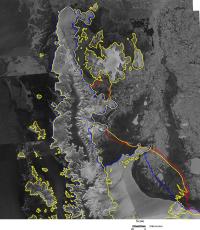
Focussing on the northern end of the Larsen Ice Shelf (fig 2), earlier coastlines are plotted from the 1997 Antarctic Mapping Mission (blue), 1992 based on SAR imagery from the European Space Agency's ERS (red, over Larsen Ice Shelf only) and the mid-1960's (yellow). The northern Larsen Ice Shelf has been retreating since the mid-1970s, with major collapses in 1990s, including 1995, shown dramatically here. The southern Larsen Ice Shelf (not shown) was advancing during this same time period until a major collapse also occurred in 1995.
The Wordie Ice Shelf (fig 3) has also been undergoing continued disintegration since the mid-1970's (yellow), with significant retreat during the 1990's through 2000 (where red is the1992 coastline and blue is the 1997).

However, closer examination of the northern and southern Larsen Shelves shows that some glaciers have experienced advancement since 1997. In the animation of the Larsen Ice Shelf using SAR imagery from 1992, 1997, and 2000 (click on larsen-trans), most of the northern shelf is retreating. Close examination of the southern Larsen Ice Shelf (lower right corner) and a small glacier tucked south of the Sobral Peninsula (south of the large island (Ross) in the upper part of imagery) advancement is clearly detected. These advancements may indicate early rebuilding of the overall extent of the Larsen Ice Shelf. These climatic-induced shelf retreats are related to rising air temperatures that in turn warm the surrounding oceans. Warming in both the air and ocean underlying the ice shelves leads to increased fracturing and eventually calving of the ice shelf fronts into icebergs. The 1995 Larsen calving events are due to anomalously warm summer temperatures in the early 1990s. The warming noted in the Antarctica Peninsula, as measured from several research stations located there, is not sufficient to affect the thicker and more extensive West Antarctic Ice Shelves to the south on the main continent. The two RADARSAT mosaics from the1997 and 2000 Antarctic Imaging Campaigns provide highly accurate snapshots of this rapidly changing region of the greater Antarctic Continent.
Ross Ice Shelf (ross_1997, ross_2000, Movies/ross_ice_shelf_loop)
The Ross Ice Shelf, in the Pacific Ocean sector, is one of the two great ice shelves of Antarctica, along with the Ronne-Filchner Ice Shelf which is located in the Atlantic Ocean sector. The Ross Ice Shelf extends hundreds of kilometers off the coastal margin, draining numerous glaciers that extend through the western Transantarctic Mountains as well as extensive glaciers in the plateau region to the north and east of the mountain range. The principle research stations of the United States (McMurdo) and New Zealand (Scott) lie on the westernmost margin of the Ross Shelf. For most of the 1900's the Ross Ice Shelf has been slowly advancing. A major calving event occurred in 1987 in the eastern sector, removing about 100 years of advance (5100 kilometers2) in that sector. However, in March 2000 a significant calving event occurred in the western sector (78 degrees South, 170 degrees west), when the ice front was at its furthermost extent in the last 150 years and a calving event had not occurred in over 90 years. This calving formed a gigantic iceberg (termed B-15) which was approximately 11,000 kilometers2 and covered an area about 290 kilometers (180 miles) by 15 kilometers (9 miles). Subsequently, several smaller icebergs have calved in adjacent areas and the large iceberg (B-15) has itself broken into smaller pieces and been swept equatorward. More recently, a large iceberg on the far west of the Ross Ice Shelf, near McMurdo station, also recently calved. The RADARSAT animation (click on ross_ice_shelf_loop) shows widening of a fracture in the westernmost portion of the Ross Ice Shelf (approximately 78 degrees South and 178 degrees East) between 1997 and 2000, covering an area approximately 225 kilometers by 140 kilometers (140 by 85 miles). This broadening suggests that this section of the Ross Ice Shelf, almost the last remaining chunk of the western shelf that did not calve off in 2000, may also calve off in the near future.
The End?
RAMP is demonstrating the technical capability to acquire nearly instantaneous high-resolution microwave imagery of the entire Antarctic Continent. The technical achievement is being followed by an unfolding scientific examination that is revealing the glaciology and geology of Antarctica in unexpected detail. As importantly, the acquisitions provide an important benchmark for gauging and understanding future changes in the Antarctic.
As this new century begins to unfold, it is interesting to reflect on the fact that we now possess the ability to regularly observe the entirety of our world with unprecedented detail and across a wide portion of the electromagnetic spectrum. The RADARSAT program, building on a scientific, engineering and political heritage going back to the early days of the Corona missions, is demonstration of that ability and of the requisite international commitment necessary to achieve such a goal. In turn, that ability levies a responsibility on the science community to forcefully argue for regular acquisition of such information in a fashion that is accessible and understandable to anyone interested in the results and pondering their implications.
So is this the end of our looks at Antarctica? We hope not!

